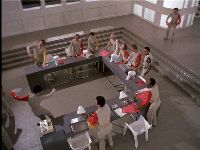Breakaway
Suspected radiation from nuclear waste containers threatens a deep space probe from Earth's space research center on the moon. It is a prologue to disaster and mankind's most fantastic adventure. ITC summary

- Scripts:
- Original pilot script: Zero G by Gerry & Sylvia Anderson (30 minutes long). Dated 1973.
- Early pilot storyline, circa 1973.
- Pilot script "The Void Ahead" by George Bellak. "First Draft Copy", undated, 71 pages; and "Temporary Final", undated, 82 pages
- Script "Turning Point", Final Shooting Script (uncredited but rewritten by Christopher Penfold) dated 5 November 1973, 71 pages
- Script "Breakaway" ("Formerly titled Turning Point"), Final Shooting Script/Amended Blue Pages, dated 22nd November 1973
- SFX filming from 5th November 1973 (although for 6 weeks a dragging brake ruined footage)
- Studio set construction began at Elstree Studios. As it was under threat of closure, the entire production moved to Pinewood Studios one weekend. All the sets had to be rebuilt. As a result they were blacklisted by the unions.
- Filming:
- Rehearsals began at Pinewood from the 26th November, with tests filmed from the 28th November, including the Meta signal.
- Shooting Schedules
- Shooting Schedule dated 29th October for filming 3 December until 18 December (12 days)
- Shooting Schedule No. 2 dated 20th December for filming 19/20th December until 2nd January.
- Shooting Schedule No. 3 dated 3rd January 1974 for filming 3rd January until 9th January.
- Filming began 3 December and lasted 26 days, across the Christmas and New Year holiday to 11 January 1974 (when the series title shots were filmed).
- 25th and 26th December were Christmas holidays, plus 1st January for New Year; they had planned to take off Christmas Eve on 24th December but did film on that day.
- After Black Sun was filmed, a further 4 days of reshooting was held (February 21,22,25 and 26).
- Some additional scenes were re-shot much later, including 7th May (Carter in Eagle shots), potentially others
- The "This Episode" sequence has several shots not in the episode. These are mainly SFX, including a magnetic grab exploding against the laser barrier, an alternative robot Eagle crash, and a rockslide (perhaps from Matter Of Life And Death. For Breakaway only, the "This Episode" caption is in lowercase against a black background (in all other episodes it is capitalised and on a blue background).
- Nick Tate was originally cast as Collins (the original character name was Carter). Another actor was originally cast as Nordstrom but became sick after the special milky contact lens had been made- it had to be used for the replacement actor (Roy Scammell).
- Edited into the 1976 Italian compilation movie Spazio 1999
- In 1979 it was edited together with War Games into a compilation movie, Alien Attack with new scenes of the International Lunar Commission discussing the events, written by Dennis Spooner and directed by Bill Lenny.
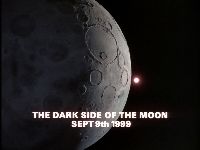

- Extensive shots of the 22" and 44" Eagles (there was only one model of each at the time). Standard transporter, pallet (carrying nuclear waste) and winch platforms are featured. Simmonds's Eagle has an orange transporter pod (only seen clearly on the 22" Eagle landing shot, and the 11" Eagle rising over the moonbase). Martin Bower has stated that this was a standard white pod; every other film frame was hand coloured red. However, there are photos of an 11" Eagle with an orange pod. The 44" transporter pod was painted at one time in orange paint, although no shots of it so painted were used in the episode.
- At least two sizes of small Moonbuggy are used in the initial shots of the astronauts approaching NDA 2.
- The Space Dock model is shown (a slightly revamped version appears in Dragon's Domain). The Meta Probe is seen only in distant shots; this is a fairly crude model.
- The Nuclear waste Disposal Areas are models in several scales, the largest being of in scale with the 44" Eagle as waste cans are extracted and dispersed. The hub of NDA 2 was constructed by long-time Anderson collaborator Mike Trim. The flashing light towers in NDA 1 would be reused in Black Sun and subsequent episodes as Moonbase Alpha's gravity generators. The waste monitoring depot (a round building) would be reused as amongst the Moonbase Alpha large scale buildings (it can be glimpsed in the background of shots of the Alpha laser batteries in The Metamorph and subsequent episodes).
- Unused Special Effects
- Library Special Effects
- SFX Storyboard
- SFX behind the scenes photos
|
  |

- Astronomer (and Space 1999 fan) Phil Plait discusses the physics of the breakaway in a March 2012 article. He calculated the waste dumps must explode with the energy yield of 1 quadrillion one megaton bombs, or 13,000 times the energy of the sun.
- The first shots of the series contain an error: the captions refer to "The Dark Side of the Moon". The Moon has a far side (the half permanently facing away from Earth), but this rotates, so there is two weeks of night followed by two weeks of day. During the two-week night, the far side is the dark side. The terminology is a common error (and a 1973 Pink Floyd album). Navigation Beacon Delta and presumably Area 2 are on the "far side". The phases of the Moon and Earth are wrong too. The sun is beyond, so the Earth and Moon would appear as thin crescents (thanks to Marcus Lindroos).
- The Space Dock appears to be in lunar orbit (not Earth orbit). It is evidently constructed from old rocket casings. The Saturn V rocket stages seen do not reach orbit so presumably they must be higher stages of much larger rockets. The tubular construction resembles the actual International Space Station being constructed in 1999 in Earth orbit, although they are no solar panels. The Meta Probe has a large array of solar panels; it is the only craft in the series to feature them.
- The etymology of the name Meta is from the Greek, "after", "beyond" or "change". In Roman chariot races, the meta was a column that marked the turning point for the chariots (Turning Point was an original title of the episode). It also anticipates Project Meta (Megachannel Extraterrestrial Assay), a 1985-1995 Planetary Society/ Harvard University radio frequency search for alien signals. The strong stellar winds of newly ignited stars (T-Tauri winds) could propel proto-planets from solar orbits into deep space. A terrestrial sized planet can outgas its own atmosphere; a 1999 issue of Nature speculates that it would accumulate a large insulating cloud of hydrogen as it left the solar system, allowing oceans to form. Gas giant planets radiate their own heat and also have raw materials in their atmospheres for organic molecules. The first free-floating planet, a gas-giant named CFBDSIR2149, was discovered in 2012. From Koenig's remark about seeing an atmosphere we presume Meta is terrestrial sized.
- Magnetic "radiation" is an odd but not illogical term for magnetic fields. In the 1980s it was proposed that the magnetic fields created by high voltage electricity is associated with cancers and psychological effects from disorientation and nausea to depression; scientific studies have suggested a weak causal effect. In the 1990s and 2000s there remain concerns about mobile (cellular) phones and transmitter masts. The "classic" symptoms of radiation sickness are not similar to the effects seen here, despite Helena's assertion (unless Nordstrom and Collins sudden flight is caused by diarrhoea).
- Lightning cannot conduct through a vacuum. A possible explanation could be that the waste dumps are venting gases through which the lightning conducts.
- A long range video picture from a Mars satellite shows the Moon leaving Earth- this is remarkable resolution. In 2007, NASA's Mars Reconnaissance Orbiter did in fact take a still picture of the Earth and the Moon from Mars orbit, 142 million kilometers (88 million miles) away. Coincidentally, the phases of the Earth and Moon and their relative positions in the NASA photograph are very similar to the picture on the Big Screen.
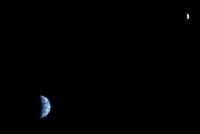
- The "gravity disruption" described by the GTV newscaster is a reasonable estimate of the damage caused by the Moon being torn from orbit. The earthquakes along the San Andreas fault, and Yugoslavia and Southern France, occur in well-known fault zones. Historically, "Yugoslavia" no longer existed in 1999 (a rump state known internationally as "Serbia and Montenegro" named itself the "Federal Republic of Yugoslavia" from 1992 to 2003). The bare newsroom (with no live footage displayed behind the newscaster, and the Trimline telephones) is somewhat dated.
- Series publicity was wildly inaccurate: according to ITC publicity the Moon is split in two by the explosion and Moonbase Alpha hurtles into space on a chunk ripped away. This was neither in the script or completed episode.
|
   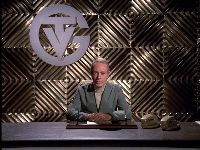 |
9th September 1999- 13th September 1999
Numerous fatalities including Jim Nordstrom, Eric Sparkman, Frank Warren. The population of 311 is presumably the figure just before the Breakaway, which killed several pilots.
- Note the female security guard in the corridor scenes (another appearance is in Guardian Of Piri). There is another female guard as well as four male guards in these scenes. See corridor extras.
- Ouma (Lon Satton) was intended to be a regular character- but disagreements amongst the cast led to him being replaced by Kano (Clifton Jones) from Matter Of Life And Death onwards.
- Simmonds (Roy Dotrice) reappeared in the episode Earthbound
Alpha Technology:
- The Space Dock appears (it is called both "space dock" and the "Meta Probe launch platform", and, in Dragon's Domain, the "interplanetary space station"). Evidently it is constructed from old rocket casings (the model makers used Airfix Saturn V rocket models). It clearly blows up during the breakaway, although the news announcer says it was blown out of orbit. It also appears, with a slight revamp, in Dragon's Domain
- We see Gorski, the previous Commander of Moonbase Alpha, presumably ousted as he could not resolve the astronaut "virus infection". He is mentioned again as Commander during 1996, in Dragon's Domain. According to War Games Koenig is the ninth commander of the base.
- Koenig's appointment presumably follows his "grounding" in 1997 after the Ultra Probe failure seen in Dragon's Domain. Victor's grounding seems to have been brief ("Still here?"). Although he was friendly with Mathias in 1996 (calling him "Bob"), here they are on formal, last name terms.
- Different designs of lunar nuclear waste area are seen in The Bringers Of Wonder and The Seance Spectre.
- Spacesuits sometimes have a plain nylon collar. The other style, a rubber corrugated collar, is used for the rest of the series.
- Note the rare use of the Command Office viewscreen.
- Medical thermographic scans are used.
- Paul uses the Eagle remote control

Eagle 1 (Simmonds, V.I.P. pod); 2 (Earth shuttle); 14 (cargo); 26 (cargo); Collins' Eagle; Koenig's NDA1 Eagle (crashed); remote Eagle (crashed); at least two cargo Eagles destroyed
- Eagles are seen with the transporter pod, the nuclear waste pallet, and the specially converted winch platforms. The transporter pod also appears in orange (Simmonds's Eagle)- the only appearance of this.
- The Eagle passenger module has lap seat belts. These are not seen again.
- The Eagle pilot section monitor screen is in colour. In all subsequent episodes they are black and white.

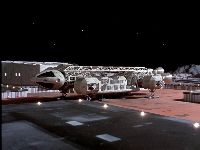

Meta at the end of the episode. We do not find out what happens there.
Aliens:
None
Props:
Footage:
- Footage of Alphans being thrown about in a corridor and Reconnaissance, and an explosion between Moonbase buildings, are reused in Force Of Life.
Cast:
- Alf Joint (Steiner) reappears as a Psychon overseer in The Metamorph

Nordstrom's spacesuit visor flaps open as he throws Steiner. Some publicity shots show Steiner's visor open as he is held up, but this does not appear in the episode.

In the later scene when Koenig, Bergman and Collins watch the astronauts, when one jumps in the buggy his entire helmet seems to almost fall off.

Nordstrom's name is spelt NORDSTROM in the monitoring depot, but NORDSTOM on his helmet.


When Koenig flies alone over Nuclear Disposal Area One and crashes, his spacesuit collar changes between scenes, from rubber corrugated to plain nylon. This also happens to Collins when he goes mad: the scenes in the Eagle and close-ups show a corrugated collar, wider scenes and stunts show the plain collar.



- The influence of 2001: A Space Odyssey is clearest in this episode. A flight to the Moon with one passenger (with stewardess). Note in particular the scene of Collins's Eagle landing at the monitoring depot, seen through a window- a similar scene in 2001 was the lunar shuttle landing at the TMA-1 site landing platform.
- The dates are not very subtle numerology, starting with 9-9-99 and ending on the 13th. Coincidentally, 9-9-99 was a key problem date for computer applications. Sylvia Anderson's birthday was September 9, Barbara Bain's birthday was September 13.
- A showcase for SFX and sets, with a chilling atmosphere. The first two acts rely on verbal exposition, before moving to more spectacular action. There is little relaxation from the building tension.
- More care than usual is shown in video inserts. People step into view or look up when the video first shows them (in later episodes, they are immediately staring directly at screen). Just before Koenig and Bergman first enter Main Mission, the video under the Big Screen shows them in the corridor outside.
- More observations
- Original "movie-length" cut
- "Spectacle overcomes the picture's inherent weaknesses" 4/5 Critical Commentary by Johnny Byrne (1975)

Cut SFX scenes, seen only in the Fanderson Space: 1999 documentary (1996). A pan across Area 2 to the Monitoring Depot, Moon flies through space with a red glowing area. Other unused special effects survive.
- Novelised in Breakaway by E C Tubb published by Orbit (UK paperback), Dobson (UK hardback), Pocket Books (US), Breitschupf (Germany), Milliyet Yayin (Turkey), re-edited in Year One (Powys, 2020).
- Novelised by Gianni Padoan in Spazio 1999 (AMZ, 1975)
- Early scripts novelised by David Hirsch in Maybe There - The Lost Stories from Space: 1999 (2022)
- A short story version is in the British 1975 Annual (online here)
- A comic strip version is in Zack 20 (German)
- Charlton Comics did a comic strip version in their magazine, issue 1, and color comic, issue 1.
- Power records did an audio version (with new actors and sound effects) for their LP "Hear Three Exciting Stories" and book and comic book.
- A 12 inch Eagle with winch pod ("Eagle Freighter") was made by Product Enterprise in 2005
- A 12 inch Eagle with winch pod was included in the "Deluxe Hangar" set made by Sixteen 12 in 2019
- A 12 inch Eagle with pallet and nuclear waste cans, and a NDA2 silo cap, was made by Sixteen 12 in 2018
- A 12 inch Eagle with orange VIP pod was made by Product Enterprise in 2006
- A 12 inch Eagle with orange VIP pod was made by Sixteen 12 in 2019
- UK video: Polygram volume 21 (1996)
- UK DVD: Carlton volume 1 (2001)
- UK DVD: Network (2005)
- UK Blu-ray: Network (2010)
- US video: Columbia House volume 1 (1997)
- US laserdisc: Image Entertainment volume 1 (1991)
- US DVD: A&E set 1 volume 1 (2001), video set 1 volume 1 (2001)
- US Blu-ray: A&E (2010)
- US Blu-ray: Shout! Factory (2019)
- Japan laserdisc: Emotion volume 1 (1993)
- Japan DVD: Pioneer (2001)
- France video: Sony Music Video volume 1 (1992)
- France DVD: TF1 (2002)
- Germany DVD: EMS (2004)
- Germany DVD: Crest (2011)
- Germany Blu-ray (SD): Crest (2011)
- Germany Blu-ray (3D): Crest (2012)
- Germany Blu-ray (HD): Sunrise Entertainment (2012)
- Germany Blu-ray (HD): Fernsehjuwelen (2015)
- Italy DVD: Pulp Video (2003)
- Italy DVD: Collector's Edition Mondo Home (2007)
- Italy DVD: Newspaper promotion La Repubblica (2007)
- Portugal DVD: Prisvideo (2003)
- Australia DVD: Magna Pacific (2003)
- Sweden DVD: Noble Entertainment (2008)
- Spanish DVD: Producciones JRB (2003)
External Links
![]()


